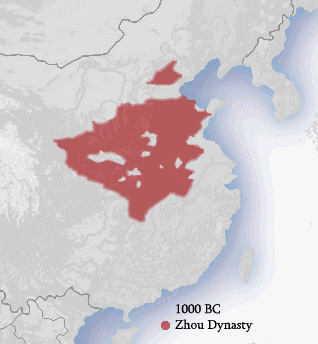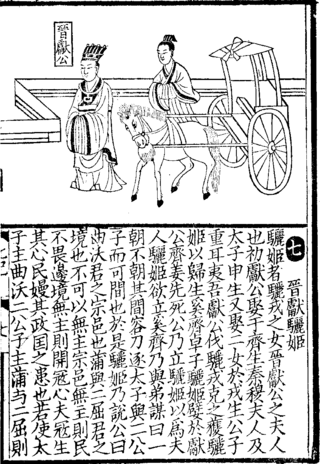Related Research Articles
The 6th century BC started on the first day of 600 BC and ended on the last day of 501 BC.

The 7th century BC began the first day of 700 BC and ended the last day of 601 BC.
The 9th century BC started the first day of 900 BC and ended the last day of 801 BC. It was a period of great change for several civilizations. In Africa, Carthage is founded by the Phoenicians. In Egypt, a severe flood covers the floor of Luxor temple, and years later, a civil war starts.

The Zhou dynasty was a royal dynasty of China that existed for 789 years from c. 1046 BC until 256 BC, the longest of such reign in Chinese history. During the Western Zhou period, the royal house, surnamed Ji, had military control over ancient China. Even as Zhou suzerainty became increasingly ceremonial over the following Eastern Zhou period (771–256 BC), the political system created by the Zhou royal house survived in some form for several additional centuries. A date of 1046 BC for the Zhou's establishment is supported by the Xia–Shang–Zhou Chronology Project and David Pankenier, but David Nivison and Edward L. Shaughnessy date the establishment to 1045 BC.

The Spring and Autumn period in Chinese history lasted approximately from 770 to 481 BCE which corresponds roughly to the first half of the Eastern Zhou period. The period's name derives from the Spring and Autumn Annals, a chronicle of the state of Lu between 722 and 481 BCE, which tradition associates with Confucius.

The Warring States period was an era in ancient Chinese history characterized by warfare, bureaucratic and military reform, and political consolidation. It followed the Spring and Autumn period and concluded with the wars of conquest that saw the state of Qin annex all the other contender states by 221 BC and found the Qin dynasty, the first imperial dynasty in Chinese history.
The Western Zhou was a period of Chinese history corresponding roughly to the first half of the Zhou dynasty. It began when King Wu of Zhou overthrew the Shang dynasty at the Battle of Muye and ended in 771 BC when Quanrong pastoralists sacked the Zhou capital at Haojing and killed King You of Zhou. The "Western" label for the period refers to the location of the Zhou royal capitals, which were clustered in the Wei River valley near present-day Xi'an.

King Ling of Zhou, personal name Ji Xiexin, was the twenty-third king of the Chinese Zhou dynasty and the eleventh of Eastern Zhou. He died in 545 BC.

Jin, originally known as Tang (唐), was a major state during the middle part of the Zhou dynasty, based near the centre of what was then China, on the lands attributed to the legendary Xia dynasty: the southern part of modern Shanxi. Although it grew in power during the Spring and Autumn period, its aristocratic structure saw it break apart when the duke lost power to his nobles. In 403 BC, the Zhou court recognized Jin's three successor states: Han, Zhao, and Wei. The Partition of Jin marks the end of the Spring and Autumn period and the beginning of the Warring States period.

Qin was an ancient Chinese state during the Zhou dynasty. It is traditionally dated to 897 BC. The Qin state originated from a reconquest of western lands that had previously been lost to the Xirong. Its location at the western edge of Chinese civilisation allowed for expansion and development that was not available to its rivals in the North China Plain.

Chu was an ancient Chinese state during the Zhou dynasty. Their first ruler was King Wu of Chu in the early 8th century BC. Chu was located in the south of the Zhou heartland and lasted during the Spring and Autumn period. At the end of the Warring States period it was destroyed by the Qin in 223 BC during the Qin's wars of unification.
King Yí of Zhou, personal name Ji Xie, was the ninth king of the Chinese Zhou Dynasty. Estimated dates of his reign are 885–878 BC or 865–858 BC.

Duke Huan of Qi, personal name Xiǎobái (小白), was the ruler of the State of Qi from 685 to 643 BC. Living during the chaotic Spring and Autumn period, as the Zhou dynasty's former vassal states fought each other for supremacy, Duke Huan and his long-time advisor Guan Zhong managed to transform Qi into China's most powerful polity. Duke Huan was eventually recognized by most of the Zhou states as well as the Zhou royal family as Hegemon of China. In this position, he fought off invasions of China by non-Zhou peoples and attempted to restore order throughout the lands. Toward the end of his more than forty-year-long reign, however, Duke Huan's power began to decline as he grew ill and Qi came to be embroiled in factional strife. Following his death in 643 BC, Qi completely lost its predominance.

Duke Xian of Jin, ancestral name Ji (姬), given name Guizhu (詭諸), was the nineteenth ruler of the State of Jin. He was also the ninth ruler of Jin in the Spring and Autumn period and the second duke of Jin. When his father, Duke Wu of Jin, died in 677 BC, Guizhu ascended the throne of Jin and became Duke Xian of Jin. He reigned for 26 years. He moved the capital from Quwo (曲沃) to Jiang (絳). He was named after a Rongdi tribe (戎狄族) leader Guizhu (詭諸) whom his father, Duke Wu of Jin, captured alive.
Duke Wu of Jin, ancestral name Ji (姬), given name Cheng (稱) and also known as Duke Wu of Quwo, was the eighteenth ruler of the state of Jin. He was also the last ruler of the state of Quwo before he gained the title as the duke of Jin.
Duke Hui of Jin, born Yiwu, was the duke of Jin during the Spring and Autumn period of China's Zhou dynasty.

The State of Xu was an independent Huaiyi state of the Chinese Bronze Age that was ruled by the Ying family (嬴) and controlled much of the Huai River valley for at least two centuries. It was centered in northern Jiangsu and Anhui.

The Eastern Zhou is a period in Chinese history comprising the latter half of the Zhou dynasty from c. 771 BCE to 256 BCE, following the Zhou capital's relocation eastward to Chengzhou, near present-day Luoyang. The Eastern Zhou was characterised by the weakened authority of the Zhou royal house, it is subdivided into two parts: the Spring and Autumn period, during which the ancient aristocracy still held power in a large number of separate polities, and the Warring States period, which saw the consolidation of territory and escalation of interstate warfare and administrative sophistication.

The State of Ni (郳國), also known as the state of Xiao Zhu (小邾國) or the state of Xiao Zhulou (小邾婁國), was segregated from Zhu (Zhulou), a vassal state of Lu, during Zhou dynasty. It was destroyed by Chu during the Warring States period.
References
- ↑ Percy, William A. (1996). Pederasty and Pedagogy in Archaic Greece. University of Illinois Press. p. 129. ISBN 978-0-252-06740-2.
- ↑ Scott, Graham P. (24 January 2023). Seeds of Western Culture: Low Chronology, Abraham's Exodus and Archilochus' Odyssey. Graham P Scott. p. 121. ISBN 978-0-646-86379-5.
- ↑ Adak, Mustafa; Thonemann, Peter (2022). Teos and Abdera: Two Cities in Peace and War. Oxford University Press. p. 82. ISBN 978-0-19-284542-9.